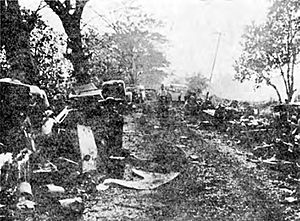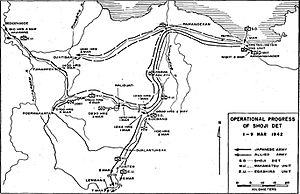Battle of Kalijati facts for kids
Quick facts for kids Battle of Kalijati |
|||||||
|---|---|---|---|---|---|---|---|
| Part of Battle of Java in the Dutch East Indies campaign | |||||||
 KNIL vehicles destroyed during the battle |
|||||||
|
|||||||
| Belligerents | |||||||
| Commanders and leaders | |||||||
| Units involved | |||||||
| Strength | |||||||
| Initial: 530 Counterattack: 4,500 |
1,200 | ||||||
The Battle of Kalijati was an important fight during World War II. It happened in Indonesia from March 1 to 3, 1942. This battle was part of the larger Dutch East Indies campaign. Japanese forces fought against Dutch colonial soldiers and their allies. The main goal was to control the Kalijati Airfield in Subang.
Japanese forces landed unexpectedly and moved very quickly. They captured the airfield on the first day. Dutch commanders could not send enough help in time. The next day, Dutch forces tried to take back the airfield. They almost succeeded but were pushed back. A second, larger Dutch attack on March 3 also failed. Japanese planes stopped most of the Dutch troops. This forced the Dutch to retreat to Bandung.
Contents
Why the Battle Happened
During the Dutch East Indies campaign, Japan wanted to take over Java. Java was a very important island. The Japanese Sixteenth Army planned the invasion. A key target was the Kalijati Airfield. This airfield was close to Java's north coast. Taking it was risky but important for Japan.
Japanese forces gathered at Cam Ranh Bay. They planned to land in West Java and East Java. On February 27, 1942, the Allies tried to stop the Japanese ships. But they failed and lost many of their own ships.
Soldiers and Landings
Early on March 1, 1942, Japanese soldiers began landing on Java. About 23,500 Japanese troops landed in different places. One group landed at Eretan Wetan, in Indramayu Regency. This group was led by Colonel Toshinari Shōji. Their main target was Bandung. Bandung was where the Dutch and Allied military leaders were based.
Allied planes tried to attack the Japanese landings at night. But bad weather made it hard for them. Japanese reports said the attacks did not stop their landings. Later, another air attack caused some injuries to the Japanese.
The Japanese chose Eretan Wetan because it was close to roads. This allowed them to move quickly with vehicles. They wanted to make a fast attack on Kalijati. The Dutch did not expect a landing there. They had few soldiers in the area. The Japanese also did not expect any fighting during their landing.
Colonel Shōji's unit had about 3,000 men. A smaller group of about 1,200 men was led by Major Shichiro Wakamatsu. This group was ordered to capture the Kalijati Airfield. The airfield was about 75 kilometers from Eretan Wetan.
At first, the Kalijati airfield was defended by 180 Dutch soldiers. These were from the KNIL. Later, 170 British soldiers took over the defense. This included both Army and Royal Air Force (RAF) units. In total, about 350 British troops were at Kalijati. On the morning of March 1, RAF pilots were told to move their planes. They flew to Andir airfield in Bandung.
The Battle Begins
By 6 AM, Major Wakamatsu's unit had left their landing spot. At 10:30 AM, their first soldiers met Dutch troops. Japanese light tanks began firing at the airfield. Planes took off from the airfield as the tanks moved in. One pilot quickly got into his plane under Japanese fire.
Dutch forces at Kalijati had trouble contacting their commanders. Heavy rain made their communications difficult. They could not report the Japanese attack until 7 AM. Before attacking Kalijati, Japanese forces fought off a Dutch counterattack. This happened at their landing point in Eretan Wetan. Japanese reports said 400 to 500 Dutch soldiers attacked.
Soon, the Dutch and British soldiers defending the airfield broke apart. They tried to escape. Japanese soldiers then moved in and took control. They stormed the last remaining strongholds. The defenders surrendered because they had no anti-tank weapons.
Dutch Counterattacks
By the afternoon of March 1, Dutch forces quickly put together a unit. This unit included 24 light tanks and armored vehicles. It also had an infantry company and three anti-tank guns. The unit left Bandung at 2 PM. But they could not reach the airfield by nightfall. So, the attack was delayed until the next day. Another larger unit, called the "Teerink Group," was also sent. This group had about 1,000 soldiers. The KNIL's 2nd Infantry Regiment also joined the effort. The first Japanese planes arrived at Kalijati by dusk on March 1.
March 2: First Counterattack
Around 8:15 AM, the first Dutch group attacked the Japanese. They were near Subang. They had some early success, pushing past the first Japanese defense line. But they could not remove the Japanese from the town. After about two hours, the Dutch began to pull back. The fighting ended around noon.
The Dutch lost at least 14 soldiers killed. Another 34 were missing. 13 of their tanks were destroyed, and 5 were badly damaged. The Japanese lost at least 20 soldiers. Throughout that evening and into the next morning, Allied planes flew missions. They looked for Japanese positions and bombed them. This was to help the Dutch counterattack. Later, the Dutch realized the Japanese had barely held on against their attack.
March 3: Second Counterattack
The main Dutch unit for the counterattack was the KNIL's 2nd Infantry Regiment. This unit had about 3,500 soldiers. Most of them had no experience in battle. Major General Jacob Pesman led this unit.
However, Japanese aircraft attacked the Dutch column moving from Bandung. The planes destroyed over 150 vehicles. They also hit many guns and ammunition supplies. This caused over 100 Dutch casualties. By this time, many Japanese air units had moved to Kalijati.
The air raids did not cause many deaths. This was because the Japanese lacked anti-personnel bombs. But the raids greatly lowered the spirits of the KNIL soldiers. Their officers found it hard to regroup their units after each attack. The soldiers were already tired from moving so quickly. Many of them broke ranks and fled. In total, about 300 men were reported dead, wounded, or missing. Only a small part of the armored unit reached the Japanese. They were quickly driven away.
The Teerink Group also lost morale because of the Japanese air raids. They failed to launch a serious attack. There was another Dutch attack against Japanese landing spots at Eretan Wetan. But Japanese artillery stopped this attack. The Dutch were forced to retreat after losing about 30 men. Most of the Japanese ground forces did not fight much against these Dutch counterattacks.
What Happened Next
The KNIL's 2nd Infantry Regiment was badly damaged after the air raids. They could not fight anymore. After securing the airfield, Colonel Shōji decided to attack Bandung directly. This led to the Battle of Tjiater Pass.
Colonel Shōji's unit and its air support received special praise. This came from Sixteenth Army Commander Hitoshi Imamura. They were honored for their actions at Kalijati and Tjiater Pass. Later, the formal surrender of the Dutch East Indies happened at the Kalijati airfield.


